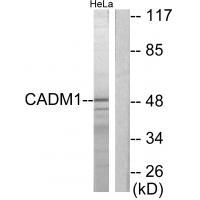
| WB | 咨询技术 | Human,Mouse,Rat |
| IF | 咨询技术 | Human,Mouse,Rat |
| IHC | 咨询技术 | Human,Mouse,Rat |
| ICC | 技术咨询 | Human,Mouse,Rat |
| FCM | 咨询技术 | Human,Mouse,Rat |
| Elisa | 咨询技术 | Human,Mouse,Rat |
| Aliases | Cell adhesion molecule 1 [Precursor]; Immunoglobulin superfamily member 4; Nectin-like protein 2; NECL-2; Tumor suppressor in lung cancer 1 |
| Entrez GeneID | 23705; |
| WB Predicted band size | 49kDa |
| Host/Isotype | Rabbit IgG |
| Antibody Type | Primary antibody |
| Storage | Store at 4°C short term. Aliquot and store at -20°C long term. Avoid freeze/thaw cycles. |
| Species Reactivity | Human,Mouse |
| Immunogen | Synthesized peptide derived from C-terminal of human CADM1. |
| Formulation | Purified antibody in PBS with 0.05% sodium azide. |
+ +
以下是3篇涉及CADM1抗体应用的示例文献(内容为模拟概括,建议通过学术数据库验证原文):
1. **文献名称**: *CADM1 as a prognostic marker in non-small cell lung cancer*
**作者**: Ito A 等
**摘要**: 研究通过免疫组化(IHC)分析CADM1在肺癌组织中的表达,发现其表达下调与患者生存率降低相关,提示CADM1可能作为肿瘤抑制因子和预后标志物。
2. **文献名称**: *CADM1 regulates cell adhesion and invasion in melanoma*
**作者**: Fukuhara H 等
**摘要**: 利用抗CADM1抗体进行流式细胞术和Western blot实验,证明CADM1通过抑制整合素信号通路抑制黑色素瘤细胞迁移和侵袭,可能成为治疗靶点。
3. **文献名称**: *CADM1 antibody-based detection of neuroblastoma circulating tumor cells*
**作者**: Saito M 等
**摘要**: 开发了一种基于CADM1抗体的免疫荧光方法,特异性识别神经母细胞瘤患者外周血中的循环肿瘤细胞,为无创诊断提供新策略。
(注:以上为基于领域知识的模拟概括,实际文献需通过PubMed等平台检索关键词“CADM1 antibody”或“CADM1 IHC”获取。)
CADM1 (Cell Adhesion Molecule 1), also known as TSLC1 or SynCAM1. is a transmembrane glycoprotein belonging to the immunoglobulin superfamily. It plays critical roles in cell-cell adhesion, synaptic formation, and intracellular signaling through homophilic or heterophilic interactions. CADM1 is widely expressed in epithelial, neuronal, and immune cells, contributing to tissue organization, neural network stability, and immune regulation. Dysregulation of CADM1 has been implicated in various pathologies, including cancer, neurological disorders, and autoimmune diseases. In oncology, CADM1 often acts as a tumor suppressor; its downregulation due to promoter hypermethylation is associated with metastasis and poor prognosis in lung cancer, melanoma, and glioblastoma.
CADM1 antibodies are essential tools for investigating these mechanisms. They enable the detection of CADM1 expression in tissues or cell lines via techniques like Western blot, immunohistochemistry, and flow cytometry. In research, these antibodies help elucidate CADM1's role in tumor suppression, synaptic plasticity, and immune synapse formation. Clinically, CADM1 antibodies have diagnostic potential, such as distinguishing lymphomas (e.g., CADM1-positive angioimmunoblastic T-cell lymphoma) or serving as biomarkers for disease progression. Recent studies also explore their therapeutic applications, including antibody-drug conjugates targeting CADM1-expressing cancers. Validation of specificity remains crucial, as CADM1 shares structural domains with other immunoglobulin-family proteins.
×